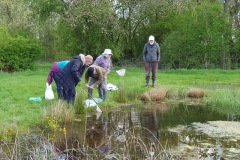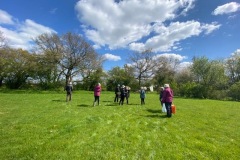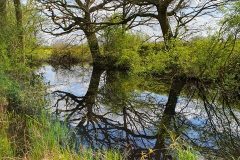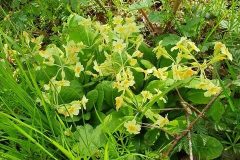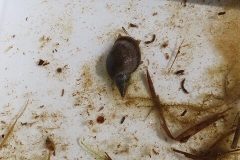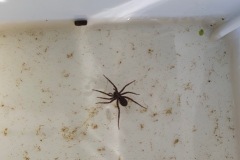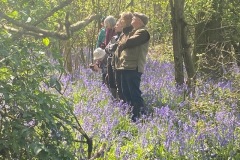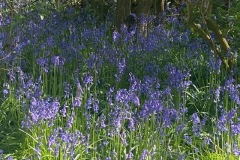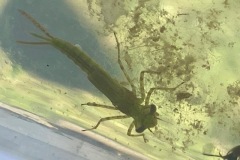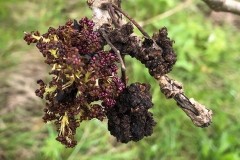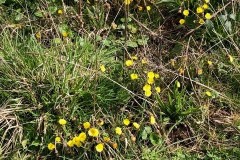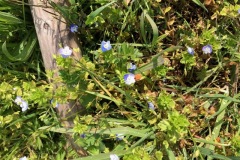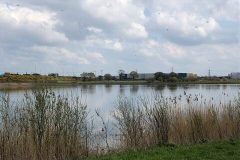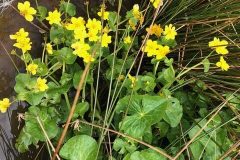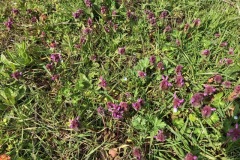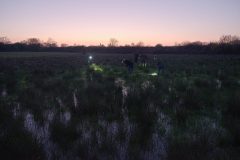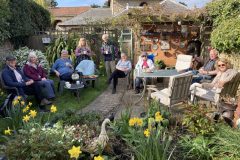Monday 25th April 2023.
Leader : Joyce Simmons.
Members present : John, Anna, Caroline, Nora, Margaret, Jeff, Gerri, Paul, Colin, Jim, Louise,
Hilary, Joyce.
We had a very enjoyable sunny afternoon visit to Ash Hill Farm. John took us on a tour of meadows and woodland pointing out unusual plants and trees, including the young woodland planted 20 years ago.
Bluebells were at their magnificent best in the older woodland, which had cameras snapping. We tried pond dipping in 2 of the ponds, the first being very productive, with lots of Mayfly larvae of many species, baby newts, snails and Whirligig beetles. The second pond was deeper and much less productive though there were Caddis fly and beetle larvae, adult beetles as well as snails.
Joyce Simmons.
Birds in song or calling (I.e. territory holding) included Blue Tit; Great Tit; Blackbird; Blackcap (in John’s wood); Chaffinch; Robin; Wren and in the distance across the fields was the bubbling call of a Curlew. Although not calling, a Buzzard circled over the fields opposite John’s house, and my first Swallow of the summer was one skimming over the buildings at the adjacent hamlet of Trumfleet. The presence of roe Deer was revealed by an old fray mark on the stem of a sapling in John’s new plantation and footprints (slots) along muddy trackways.
Louise, (fresh from the Thorpe Marsh amphibian evening) pointed out the submerged folded over leaves of Water Forget-me-not where Smooth Newt eggs had been secreted. The pond dipping quickly revealed freshly emerged newt ‘efts’ (newtlings). We were also quickly chasing the nymphal stages of Notonecta (back-swimmer) water boatmen and Corixia (front-swimmer) lesser water-boatmen and a Water Mite Hydracharina. Water snails included the Great Pond Snail Lymnaea stagnalis; Wandering Snail Lymnaea peregra and one of the small Ramshorn Snails Planorbis planorbis. Small adult water beetles, possibly Agabus or Ilybius, were too nimble to catch though a corpulent, transparent fly larvae was intent on extruding then re-imbibing its own innards! The elegant nymphal stages of Damsel flies with three prominent leaf-like caudal lamellae (gills), contrasted with the Squat, spiny, heavy-weight Dragonfly nymph (possibly Libellula depressa).
Fascinating field observations to which John drew or attention were 1) gatherings of grasses dragged to line/insulate a badger sett in the bank of one of the deep IDB drains. 2) a ‘four-square’ front foot print of a Badger (could have been evidence of a small Bear!) and 3) the accumulated snail shell fragments of a Thrush’s ‘anvil’. In a region without any exposed solid geology, thrushes have to be opportunistic in the substrate against which they smash open snail shells. In this case it was a large chunk of Magnesian Limestone (discretely positioned in a hedge bottom), from demolition debris brought in to mend one of the unmetalled farm tracks. It looked like all the snails were the brown-lipped snail Cepaea nemoralis, a species evidently preferred (or possibly easier to smash open) to the common garden snail Helix aspersa .
CAH.
Monday 17th April 2023.
Leader : Nora Boyle.
Members present : Gerri (S), Carol, Hilary and Nora (B).
Apologies: Colin (H)
The meeting started in the playground between Pegasus Way and Magenta Crescent, off Woodfield Way at 10.30 am. We walked along the track towards the lakes passing the entrance to Carr Lodge which was avoided because when I did the recce on Saturday the path was extremely wet and muddy.
We stopped part way along the track to look over a fence at the Highland cattle in a field managed by the Yorkshire Wildlife Trust, noting the presence of White Dead Nettle, Cleavers and Jack by the Hedge near the gate. Walking over the M18 bridge we noted the road was bordered mainly by Ash, Hawthorn, Dog Rose, Gorse and a species of Prunus. Some of the ash trees were just in flower but others were bearing leaf buds in the process of opening.
Continuing past Annabel’s cafe we headed towards the storage units on the skyline, stopping for a short time to look at the birds on one of the islands and admire the sound and flight of Skylark. On the way there were many examples of Red Dead nettle and a two species of Speedwell. We found one example of Yarrow in flower and several clumps of Coltsfoot, some in flower and many others which had gone to seed.
To the right of the path was an island covered with Black Headed gulls which created a cacophony of sound drowning out some of the noise from the motorway. Following the track round the lake closest to the storage units we found many examples of old teasel heads, the new leaf rosettes of Teasel, Salad Burnet and a grass which I believe was Meadow Foxtail. On one of the willow saplings growing amongst the Common Reeds we saw a bird which was later identified, from Hilary’s description, by a fellow birdwatcher to be Wheatear.
We soon reached the end of the path between two of the lakes which took us back in the direction of Annabel’s. There we found many examples of Marsh Marigold growing on the edges of the water. The path ahead then went round one of the other lakes taking us back to Annabel’s and passing another island where we saw one solitary Oystercatcher amongst the Black Headed gulls. By the sides of the paths there were many examples of species of plants just in leaf but we did see one example of Red Campion in flower.
On our journey round the lakes we also saw Tufted Duck, Great Crested Grebe, Greylag geese, Mute Swan, Gadwall, Cormorant, Little Egret, Mallard, Coot and Moorhen. We approached Annabel’s at 12.40pm for a welcome bite to eat and drink in the cafe which we had all to ourselves for a short while. I was pleased that we hadn’t been plagued with as many flies as I had encountered on Saturday. I think some of the flies I saw by the M18 lake were St Mark’s flies recognisable by the way they dangle their legs. If you look closely at my last photograph from Saturday you might just be able to pick them out !
Nora Boyle.
.
Tuesday 11th April 2023.
Leader : Mick Townsend.
Members present : Three members present plus three Thorpe Marsh volunteers.
They found 100 folded leaves. Most that were looked at (only a sample) were Smooth Newts but there were a few Great Crested Newt eggs. They saw 9 or 10 Smooth and 3 or 4 Great Crested Newts.
Report provided by Mick Townsend.
Saturday 8th April 2023, 2 pm to 4.15 pm.
Leader & Key-holder : Margaret Prior.
Members present : Nora (B); Gerri (S); Caroline (B); Jim (B); Tom & Diana (H); John (N) & Colin (H).
Introduction:
The history of the discovery, management and monitoring of the population of Snakes-head Fritillary on the Owston Glebe fields (SE5511) is published in the following papers by Pip Seccombe :-
1983 Pip’s pasture. The Doncaster Naturalist 1 (3): 38-40.
2002 Twenty years of recording Fritillaries. YNU Bulletin 37 Supplement for YNU Conference 2000 Recording & Monitoring Yorkshire’s Natural Environment. Pp. 91-92.
2011 Pip’s pasture – an update. The Doncaster Naturalist 2 (2): 55-64.
The Owston population is included in the national review by Kevin Walker. Walker, K.J. (2021) Snake’s-head Fritillary Fritillaria meleagris (Liliaceae) in Britain: its distribution, habitats and status. British & Irish Botany 3(3): 263-278.
Due to the Owston Fritillary populations occurring in the context of historic species-rich hay meadows, the fields were designated by English Nature (now Natural England) as a statutory Site of Special Scientific Interest. They are currently managed by the Yorkshire Wildlife Trust.
Aims: The aims of the visit were to commemorate the work of our late and much missed colleague Pip Seccombe, to continue monitoring the number of flowering Fritillaries and to search for additional populations.
| Red Flowers | White Flowers | Non-flowering | Field Ref. |
|---|---|---|---|
| Non found | Non found | Non found | Field 1 |
| 120 | 26 | Not counted | Field 2 SE5538 1127 |
| 2 | Not counted | Field 2 SE5532 1128 | |
| 12 | 4 | Not counted | Field 3 SE5506 1123 |
| 10 | 2 | Not counted | Field 3 SE5525 1125 |
| 144 | 32 | Total Flowering Plants | |
176 plants were in flower (144 red chequered & 32 white). These were in three to four populations within fields 2 and 3.
Several Bumble bee Queens (Bombus lucorum) were seen visiting the populations and some were actually watched as they gathered pollen. However, the presence of a lily beetle (Lilioceris lilii), a non-native species which attacks all parts of fritillary plants, is evidence of a significant threat to the Owston plants.
Acknowledgement: After our most enjoyable visit on such a warm (14.5oC) and sunny afternoon, the group was invited by Margaret and Jeff Prior for coffee and home-made biscuits in their walled garden.
Appendix
Note : Plants in flower or in fruit are shown as BOLD.
| Botanical Name | Vernacular Name |
|---|---|
| Acer pseudoplatanus | Sycamore |
| Aiaria petiolatell | Jack-by-the-hedge |
| Allium ursinum | Wild Garlic (Ramsons) |
| Anemone nemorosa | Wood Anemone |
| Angelica sylvestris | Wild Angelica |
| Anthriscus sylvestris | Cow Parsley |
| Arum maculatum | Arum |
| Bellis perennis | Daisy |
| Betula pendula | Silver Birch |
| Centaurea nigra | Common Knapweed |
| Cirsium arvense | Creeping Thistle |
| Conopodium majus | Pignut |
| Corylus avellana | Hazel |
| Crataegus monogyna | Hawthorn |
| Dactylis glomerata | Cock’s-foot |
| Deschampsia cespitosa | Tufted Hairgrass |
| Epilbium hirsutum | Hairy Willowherb |
| Equisetum arvense | Field Horsetail |
| Ficaria verna | Lesser Celandine |
| Filipendula ulmaria | Meadowsweet |
| Fraxinus excelsior | Ash |
| Galium aparine | Cleavers |
| Geranium robertianum | Herb Robert |
| Glechoma hederacea | Ground Ivy |
| Hedera helix | Ivy |
| Heracleum sphondylium | Hogweed |
| Hyacinthoides non-scripta | Bluebell |
| Ilex aquifolium | Holly |
| Iris foetidissima | Stinking Iris |
| Lamium album | White Dead Nettle |
| Lamium purpureum | Red Dead Nettle |
| Ligustrum vulgare | Wild Privet |
| Lonicera periclymenum | Honeysuckle |
| Luzula campestris | Field Woodrush |
| Mercurialis perennis | Dog’s Mercury |
| Plantago lanceolata | Ribwort Plantain |
| Plantago major | Broad-leaved Plantain |
| Potentilla reptans | Creeping Cinquefoil |
| Primula vulgaris | Primrose |
| Primula veris | Cowslip |
| Prunus avium | Wild Cherry |
| Prunus spinosa | Blackthorn |
| Quercus robur | Pedunculate Oak |
| Ranunculus acris | Meadow Buttercup |
| Ranunculus repens | Creeping Buttercup |
| Rhinanthus minor | Yellow Rattle |
| Rosa campestris | Field Rose |
| Rosa canina | Dog Rose |
| Rubus fruticosus | Bramble |
| Rumex obtusifolius | Broad Dock |
| Salix caprea | Goat Willow |
| Sabucus nigram | Elder |
| Senecio vulgaris | Groundsel |
| Stachis sylvatica | Hedge Woundwort |
| Stellaria media | Common Chickweed |
| Taraxacum officinale agg | Dandelion sp. |
| Taxus baccata | Yew |
| Ulmus glabra | Wych Elm |
| Urtica dioica | Stinging Nettle |
| Veronica persica | Field Speedwell |
| Botanical Name | Vernacular Name |
|---|---|
| COLEOPTERA | |
| Lilioceris lilii | Lily Beetle (on Fritillary flower!) |
| DIPTERA | |
| Bombylius major | Dark-edged Bee-fly (seen by CB) |
| HYMENOPTERA | |
| Bombus lapidarius | Red-tailed Bumblebee (Queen) |
| Bombus lucorum) | A White-tailed Bumblebee (Queen) |
| LEPIDOPTERA (Butterflies) | |
| Brimstone Butterfly | |
| Comma Butterfly | |
| Peacock Butterfly | |
| BIRDS | |
| Blackbird (calling) | |
| Buzzard (calling) | |
| Carrion Crow | |
| Chiffchaff (singing) | |
| Great Tit (calling) | |
| Nuthatch (calling) | |
| Pheasant | |
| Robin (singing) | |
| Mistle Thrush (singing) | |
| Wood Pigeon | |
| Wren (singing) | |
| MAMMELS | |
| Mole (hills) | |
| Grey Squirrel | |
| Rabbit (Droppings) | |
Monday 3rd April 2023. 1:30pm to 4.15pm
Leader : Colin Howes.
Also present : Nora (B); Gerri (S) & John (S).
Prelude:
Due to problems of safe access to the Went Gorge at Wentbridge, to see the springtime carpets of Wood Anemones, it was decided to divert to Wadworth Wood south of the M18 to experience a similar limestone woodland flora.
We arranged to meet at the western end of Short Gate, Wadworth, parking outside the agricultural buildings, keeping clear of any entrances or gateways and walking the final section of Short Gate onto the woodland rides (as we had on 10 April 2022).
While assembling, we were challenged by a local householder who claimed that (1) Short Gate was a private road [in fact there was no signage to that effect], (2) we were obstructing access to the farm buildings [in fact we weren’t parked over any entrances or gateways], and (3) that where we had parked left us vulnerable to damage from the huge pieces of agricultural equipment operating in the area … Spraying rigs were mentioned. [We observed that due to the prevailing brisk winds, spraying would be illegal under these condition]. She further advised that Wadworth Wood was Private, (belonging to the Foljambe Estate and that official access was via a public footpath across the arable fields either from Wadworth Village (Hall Farm SK566972) or from Green Lane (at SK563972).
Altered Route: Since the above mentioned advice was going to create further parking problems and involve long walks across treated crops, we decided to make for the layby on Long Gate (the B6094 at SK555961) and to access the wood via Paddock Lane, the signposted Bridle Way. We decided to limit our route to clearly defined woodland rides, heading north towards the motorway underpass (SK552972), east along the Wadworth public footpath to SK554972 and returning south via Centre Riding to SK556967 and the short length of the perimeter woodland track, re-joining Paddock Lane at SK554966 and back to the busy B6094.
Aims: The aims of the excursion were to enjoy the flush of spring flowers, particularly the Wood Anemones and to record the arrival of any spring migrants (not to forget records for Mick Townsends Phenology monitoring). The wood (recognised as a DMBC Local Wildlife Site) was surveyed by the Doncaster Nats in 1992 & 93, and was the subject of a Nats publication edited by Dorothy Bramley (Bramley, 1993).
Acknowledgement: Many thanks are due to John Scott for making our day with his constant advice on flower identification and in demonstrating his impressive ability to identify plants from the slightest showing of green!
Note : Plants in bold were in flower.
| Botanical Name | Vernacular Name | SK5596 | SK5597 |
|---|---|---|---|
| Acer pseudoplatanus | Sycamore | * | * |
| Alliaria petiolata | Jack-by-the-hedge | * | * |
| Allium ursinum | Wild Garlic (Ramsons) | * | * |
| Alnus glutinosa | Alder | * | |
| Anemone nemorosa | Wood Anemone | * | * |
| Angelica sylvestris | Wild Angelica | * | |
| Anthriscus sylvestris | Cow Parsley | * | |
| Arum maculatum | Arum | * | * |
| Bellis perennis | Daisy | * | * |
| Betula pendula | Silver Birch | * | * |
| Brachypodium sylvaticum | False Brome | * | * |
| Centaurea nigra | Common Knapweed | * | * |
| Cirsium arvense | Creeping Thistle | * | * |
| Conopodium majus | Pignut | * | |
| Cornus sanguinea | Dogwood | * | * |
| Corylus avellana | Hazel | * | * |
| Crataegus monogyna | Hawthorn | * | * |
| Dactylis glomerata | Cock’s-foot | * | * |
| Daphne laureola | Spurge Laurel | * | |
| Deschampsia flexuosa | Wavy Hair-grass | * | * |
| Epilbium hirsutum | Hairy Willowherb | * | * |
| Euonymus europaeus | Spindle | * | * |
| Fagus sylaticus | Beech | * | * |
| Ficaria verna | Lesser Celandine | * | * |
| Filipendula ulmaria | Meadowsweet | * | * |
| Fraxinus excelsior | Ash | * | * |
| Galium aparine | Cleavers | * | * |
| Geranium robertianum | Herb Robert | * | * |
| Geum rivale | Water Avens | * | * |
| Glechoma hederacea | Ground Ivy | * | * |
| Hedera helix | Ivy | * | * |
| Heracleum sphondylium | Hogweed | * | * |
| Hyacinthoides non-scripta | Bluebell | * | * |
| Hypericum tetrapterum | Square-stemmed St John’s-wort | * | |
| Ilex aquifolium | Holly | * | * |
| Lamium album | White Dead Nettle | * | * |
| Lamium purpureum | Red Dead Nettle | * | * |
| Ligustrum vulgare | Wild Privet | * | * |
| Lonicera periclymenum | Honeysuckle | * | * |
| Lysimachia nemorum | Yellow Pimpernel | * | |
| Mercurialis perennis | Dog’s Mercury | * | * |
| Pinus nigra | Corsican Pine | * | * |
| Pinus sylvestris | Scots Pine | * | * |
| Plantago lanceolata | Ribwort Plantain | * | * |
| Plantago major | Broad-leaved Plantain | * | * |
| Potentilla reptans | Creeping Cinquefoil | * | * |
| Primula vulgaris | Primrose | * | * |
| Prunus avium | Wild Cherry | * | * |
| Prunus spinosa | Blackthorn | * | * |
| Pteridium aquilinum | Bracken | * | * |
| Quercus robur | Pedunculate Oak | * | * |
| Quercus cerris | Turkey Oak | * | |
| Ranunculus repens | Creeping Buttercup | * | * |
| Rosa campestris | Field Rose | * | * |
| Rosa canina | Dog Rose | * | |
| Rosa spinosissima | Burnet Rose | * | |
| Rubus caesius | Dewberry | * | |
| Rubus fruticosus | Bramble | * | * |
| Rumex obtusifolius | Broad Dock | * | * |
| Salix caprea | Goat Willow | * | * |
| Sambucus nigra | Elder | * | * |
| Senecio vulgaris | Groundsel | * | * |
| Stachis sylvatica | Hedge Woundwort | * | |
| Stellaria holostea | Great Stitchwort | * | * |
| Stellaria media | Common Chickweed | * | * |
| Taraxacum officinale agg | Dandelion sp. | * | * |
| Taxus baccata | Yew | * | * |
| Teucreum scorodonia | Wood Sage | * | |
| Tilia cordata | Small-leaved Lime | * | |
| Ulmus glabra | Wych Elm | * | * |
| Urtica dioica | Stinging Nettle | * | * |
| Veronica beccabunga | Brooklime | * | * |
| Veronica persica | Field Speedwell | * | * |
| Viola richenbachiana | Early Dog Violet | * | * |
| Viola riviniana | Common Dog Violet | * | * |
| Botanical Name | Vernacular Name | SK5596 | SK5597 |
|---|---|---|---|
| FUNGI | |||
| Trametes versicolor | Turkey Tail | * | |
| DIPTERA | |||
| Bombylius major | Dark-edged Bee-fly | * | |
| HYMENOPTERA | |||
| Bombus lapidarius | Red-tailed Bumblebee (Queen) | * | * |
| Andrena fulva | Tawny Mining Bee (Visiting newly excavated hole in marl soil in root-plate of wind-thrown elm) | * | |
| LEPIDOPTERA (Butterflies) | |||
| Brimstone Butterfly | * | ||
| Comma Butterfly | * | ||
| BIRDS | |||
| Blackbird (calling) | * | * | |
| Buzzard (calling) | * | ||
| Carrion Crow | * | * | |
| Chiffchaff (singing) | * | ||
| Great Tit (calling) | * | * | |
| Nuthatch (calling) | * | ||
| Pheasant | * | ||
| Robin (singing) | * | * | |
| Mistle Thrush (singing) | * | ||
| Wood Pigeon | * | * | |
| Wren (singing) | * | * | |
| Mammals | |||
| Mole (hills) | * | * | |
| Roe Deer (Foot prints) | * | * | |
| Red Deer (Foot prints) | * | ||
| Grey Squirrel (chewed pine cones) | * | * | |
| Rabbit (Droppings) | * | * |
References :
Bramley, D. (ed.) A Survey of Wadworth Wood, Doncaster. Doncaster Naturalists’ Society (1993)
Recorder CAH.
